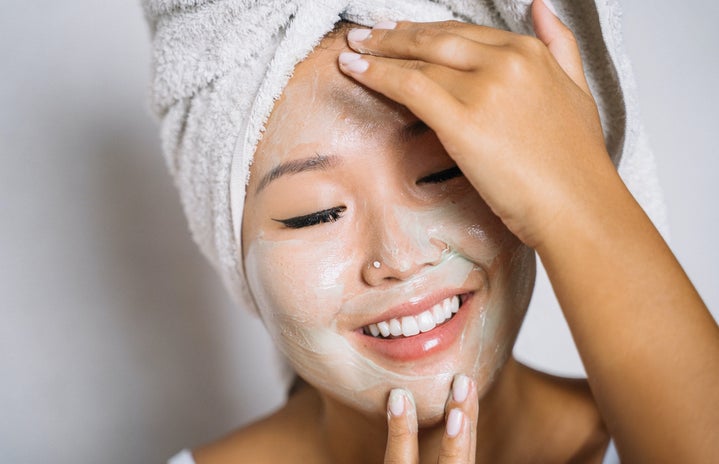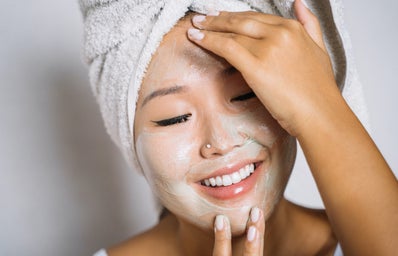How often do you take the time to read the ingredients list on anything, let alone on the back of your beauty products? Let me show you some crucial tips to building the healthiest skincare routine.
Some common toxic chemicals to AVOID
Fragrance
It’s hard not to find a product that doesn’t have “fragrance” or “parfum” listed in its ingredient list. But what the heck is it even made of? Fragrance is considered to be a trade secret, so brands don’t have to disclose what chemicals are used. What a sneaky move. It’s also important to note that both natural and artificial fragrances can irritate your skin. While it’s hard to avoid fragrances completely, look for products that have very low concentrations to avoid causing red and inflamed skin.
Parabens
Parabens (like butylparaben, propylparaben, methylparaben and isobutyl paraben) are used as preservatives that prolong product shelf life. The FDA classifies them as “safe for use” in cosmetic products but it’s shown in research that paraben particles can easily be absorbed through the skin. Once in the body, it can interfere with our hormone, reproductive and brain functions.
Formaldehyde
Here’s another chemical preservative that’s used to prevent bacterial growth. It’s considered to be a human carcinogen but since it’s used in such small amounts in skincare, manufacturers don’t consider it a health risk. But why put yourself at risk even with minimal exposure? Plus, it’s a major skin irritant.
Phthalates
These are salts or plasticizers that are used as softeners and help with the product’s ability to spread. This is another chemical that the FDA has determined doesn’t have major health risks, but they’re shown to disrupt the endocrine and reproductive system, which is linked to developmental toxins and interfering with hormone production. They’re used so often in fragrances that they’re often not even listed in the ingredients, so be sure to look for specific labels that say “phthalate-free.”
Alcohol
It’s super common to find alcohol in all sorts of beauty products; they help products absorb better, dry quicker and are used as a preservative. This is where it gets tricky – there are so many different types of alcohols out there and not all are bad. Denature alcohols (ethanol, methanol, isopropanol, etc.) – usually found in toners, cleansers and soaps – are extremely irritating for the skin. You’ll notice that it makes your skin feel tight, dry or flaky, as it is damaging your skin’s natural moisture barrier. Fatty alcohols (stearyl, cete aryl and cetyl) are emulsifiers, which means they help to keep liquid and oil together in products like moisturizers and sunscreens. Don’t get these types of alcohol mixed up with the others; emulsifiers have moisturizing properties and are actually better for the skin.
Siloxanes
Siloxanes are silicon-based chemicals that help products like moisturizers and facial treatments to dry quicker, creating smoothness and lubricity. However, be on the lookout for different versions of this chemical. Dimethicone, cyclotetrasiloxane (D4) and cyclopentasiloxane (D5) – just to name a few – are harmful to your reproductive and immune system and are even toxic for the environment.
Polyethylene glycol (PEGs)
You’ll commonly find PEGs in cream-based products as they’re used as chemical thickeners. It’s argued that they are safe at low levels and can be beneficial by helping products better penetrate the skin. But be wary of higher concentrations, as they can be highly irritating to the skin (especially if you have sensitive skin).
Oxybenzone
This is another endocrine disruptor that’s found in many skincare products like lotions, lip balms and cleansers. It’s also super common in sunscreen. However, it’s not just bad for our hormone production, but can cause skin allergies and is bad for the environment (especially on the coral reefs).
Sodium Lauryl Sulfates (SLS)
Sulfates are cleaning agents that help to remove dirt and oil. They’re commonly added as a foaming agent to create a rich lather. Although they’re not classified as an allergenic, they can be irritating to the eyes and skin. The good thing is there are many sulfate-free options out there, especially in hair care products.
While it might be difficult (or even impossible) to avoid certain ingredients, some may prove to be beneficial and safe at lower levels, which can be identified if they’re listed closer to the end of the ingredients list. It’s an absolute no-go if they’re one of the top three ingredients. Learn how to read an ingredient list with this helpful video from Hyram:
Consider adding these active ingredients to your routine
Hyaluronic acid
This is hands down my current favourite serum in my skincare routine. If you want plumper and dewier-looking skin, you NEED to add this to your routine. Hyaluronic acid is found naturally on the skin where it binds water with collagen to increase hydration in the skin, making you glow.
Alpha-hydroxy acid (AHA)
AHAs are commonly derived from sugarcane, milk and fruit. They’re one type of chemical exfoliant that helps to remove dead skin cells on the surface of the skin to reveal a new layer of skin cells below. Popular examples include glycolic acid (sugarcane), lactic acid (milk) and malic acid (apples).
Beta hydroxy acid (BHA)
BHAs are the other type of acid exfoliants. They’re derived from willow tree bark, wintergreen leaves or even sweet birch bark. This type of chemical exfoliant softens and dissolves keratin in the skin to more effectively shed off dead skin cells. They do this by working inside of the pore to help regulate skin cell turnover and increase shedding. Salicylic acid is one of the most common choices when it comes to BHAs – it’s pretty strong and has anti-inflammatory properties.
Vitamin B3 (Niacinamide)
Niacinamide (B3) is known for its restorative properties – a powerful ingredient used to moisturize and brighten the skin. It’s gentle enough for sensitive skin, great for redness, helps to repair your skin barrier and can fight premature signs of aging. It’s best to use in low concentrations because high concentrations and overuse can lead to skin irritation.
Vitamin C
Here’s an antioxidant that helps with your body’s natural ability to regenerate skin cells. It does this by accelerating your skin’s production of collagen and elastin to make your skin look plump and firm. Vitamin C also helps with fading dark spots and treating hyperpigmentation without affecting your skin’s normal pigmentation.
Natural oils
In general, adding a natural oil to your skincare routine is beneficial for all types of skin. Oils can help with skin elasticity, collagen production and regenerate the skin barrier.
Take a look into rosehip, marula or squalane oil.
Retinol
You might know of retinol for helping with fine lines and wrinkles, but it can also help with refining skin texture, increasing the rate of skin cell turnover and brightening your skin tone. Most surprisingly? It also helps to treat acne and clear pores.
Here’s a helpful video to learn more about active acids:
Clean Beauty Brands to Try Out (by Canadians!)
Here are some of my top picks for clean, Canadian beauty brands to check out:
The Ordinary
For a wide range of affordable active acids, shop The Ordinary. You won’t be disappointed.
Cake Beauty
For vegan and cruelty-free skincare, haircare and body care, shop Cake Beauty. You can find them at your local Shoppers Drug Mart!
BLUME
For organic skincare treatments, shop BLUME. They’re not just known for their sustainable period products but also their clean essentials. Found at Sephora!
Luna Oil Organics
For luxurious facial oils and serums, shop Luna Oil Organics. They design with Ayurveda principles in mind and only use 100% natural and organic ingredients.
Skin Essence Organics
For certified organic skincare, shop Skin Essence Organics. They have delicate extraction processes to preserve their ingredients in the most natural form possible for the highest quality.
Province Apothecary
For clean, effective products that work on even the most sensitive skin types, shop Province Apothecary. They also only produce in small batches to preserve their exceptional quality.
Harlow Skin Co.
For simple ingredient lists, shop Harlow Skin Co. They keep it short and to the point, as their ingredient lists always under 12.
I’ve only scratched the surface when it comes to cleaner skincare 101. Trust me when I say, you’re gonna want to learn more. Look into what works for your skin type and specific needs, as well as layering, meaning what products work with what and how to create the perfect skincare routine.



